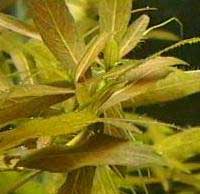home aquariums
ENCYCLOPEDIA OF PLANTS
Hygrophila polysperma (hygrophila polyspermous or hygrophila Indian)

Acanthaceae (acanthus family).
Distribution India, Bhutan, brought to Mexico.
Perennial marsh plant with creeping or erect shoots, underwater 15 - 50 cm tall. Stem glabrous, thickness 1 - 2 mm. Phyllotaxy cruciate-opposite, sessile or on short stalks, up to 7 cm and 1.5 cm wide, underwater soft and light green, yellowish-green to brownish color: hard surface and neutral green. The apex usually rounded, base suzhёnoe.
Flower stalks with short internodes, the lower leaves about 1 cm long and 0.5 cm wide, lowered, the higher, the less and less. Inflorescence length of 5 - 10 cm, with single, axillary, very small flowers; The covering sheet 2, about 1 x 5 mm in size, lowered; 5 sepals, hairy, length of 5 - 6 mm and less than 0.5 mm. Whisk the length is less than a cup, two-lipped, white or purple blёklo; upper lip 2-Lower - 3-lobed. It has 2 stamens, reaching the edge of the pavilion, 1 pistil. The seeds were found.
Hygrophila polyspermous - unassuming and recommended aquarium plant that is able to withstand these conditions of detention, where many aquatic plants die. It grows well in a soft, but especially prefers hard water at a temperature of 22 - 28 degrees C. With intense light from the plants develop powerful elite. In poorly lit aquariums can be seen that although the plant is developing normally, but the pace of growth is slowing sharply, the shoots become smaller and therefore less decorative. The soil for plant nutrition plays a secondary role. Its quite satisfied with washed sand. Additional CO2 saturation in general though, and supports the growth rate in the tank for this type is not necessary.
Gigrofilu Indian group planted in the front or middle of the aquarium term. Shoots due to their rapid growth must be trimmed every two to four weeks. Reproduction of lateral shoots. This type gigrofily particularly suitable as the first plant in the newly Being equipped aquarium. Formation of inflorescences occurs very rarely in surface shoots.


Comments
Commenting, keep in mind that the content and the tone of your messages can hurt the feelings of real people, show respect and tolerance to his interlocutors, even if you do not share their opinion, your behavior in terms of freedom of speech and anonymity offered by the Internet, is changing not only virtual, but real world. All comments are hidden from the index, spam control.